Our Group organises 3000+ Global Conferenceseries Events every year across USA, Europe & Asia with support from 1000 more scientific Societies and Publishes 700+ Open Access Journals which contains over 50000 eminent personalities, reputed scientists as editorial board members.
Open Access Journals gaining more Readers and Citations
700 Journals and 15,000,000 Readers Each Journal is getting 25,000+ Readers
Google Scholar citation report
Citations : 5125
Journal of Earth Science & Climatic Change received 5125 citations as per Google Scholar report
Journal of Earth Science & Climatic Change peer review process verified at publons
Indexed In
- CAS Source Index (CASSI)
- Index Copernicus
- Google Scholar
- Sherpa Romeo
- Online Access to Research in the Environment (OARE)
- Open J Gate
- Genamics JournalSeek
- JournalTOCs
- Ulrich's Periodicals Directory
- Access to Global Online Research in Agriculture (AGORA)
- Centre for Agriculture and Biosciences International (CABI)
- RefSeek
- Hamdard University
- EBSCO A-Z
- OCLC- WorldCat
- Proquest Summons
- SWB online catalog
- Publons
- Euro Pub
- ICMJE
Useful Links
Recommended Journals
Related Subjects
Share This Page
In Association with

A model on the effect of petroleum production on Earth s temperature
5th International Conference on Earth Science & Climate Change
George Chilingar and M Mehdi M Shamsi
University of Southern California, USA
ScientificTracks Abstracts: J Earth Sci Clim Change
Abstract
The following adiabatic model is used to relate the atmospheric temperature to the atmospheric pressure. The temperature distribution in planetâ�?�?s troposphere (including the Earthâ�?�?s troposphere) at pressure more than 0.2 atmospheres under greenhouse effect theory can be determined using the following equation: ( ) �?± �?± Ï�? Ï�? Ï�? Ï�? Ï�? Ï�? Ï�?     ï£¬ï£ ï£«                 ï£¬ï£ ï£« + �?�? + �?�? �?�? â�?�? â�?�? = 0 1/ 4 1 cos 2 2 / 2 4 / 2 / 2 1 P T b S A P Where S is the solar constant; Ï�? is the Stefan-Boltzmann constant; A is the planetâ�?�?s reflectivity; b is a scaling factor; �?± is the adiabatic exponent; and Ï�? is the precession angle of the revolving planet. Model allows one to analyze the temperature changes due to variation in mass and chemical composition of the atmosphere. The proposed model considers the global temperature changes due to variations in mass and chemical composition of the atmosphere. Based on our model, releasing of anthropogenic carbon dioxide and methane into the atmosphere does not have any appreciable effect on the average parameters of the Earthâ�?�?s heat regime. Furthermore, they have no essential effect on the Earthâ�?�?s climate. By considering different factors in the model, authors believe that all petroleum production and other anthropogenic activities resulting in accumulation of additional amounts of methane and carbon dioxide in the atmosphere does not increase the Earthâ�?�?s temperature but instead decreases the temperature. The authors also have shown that in many cases, peaks in the sun radiation precede peaks in the CO2 concentration in the atmosphere. The authors predict slow temperature decline by 2016-2020, with stronger cooling by around 2040. The earth is about 20 years away from â�?�?little ice ageâ�?.Biography
George Chilingar is an American-Armenian Professor of Civil and Petroleum Engineering at the University of Southern California (USC). He received his Bachelor’s and Master’s degrees in Petroleum Engineering and a PhD in Geology, all at USC. He has published 72 books and over 500 of articles on geology, petroleum engineering and environmental engineering.
Email: Gchiling@usc.edu mollanou@usc.edu

 Spanish
Spanish  Chinese
Chinese  Russian
Russian  German
German  French
French  Japanese
Japanese  Portuguese
Portuguese  Hindi
Hindi 
